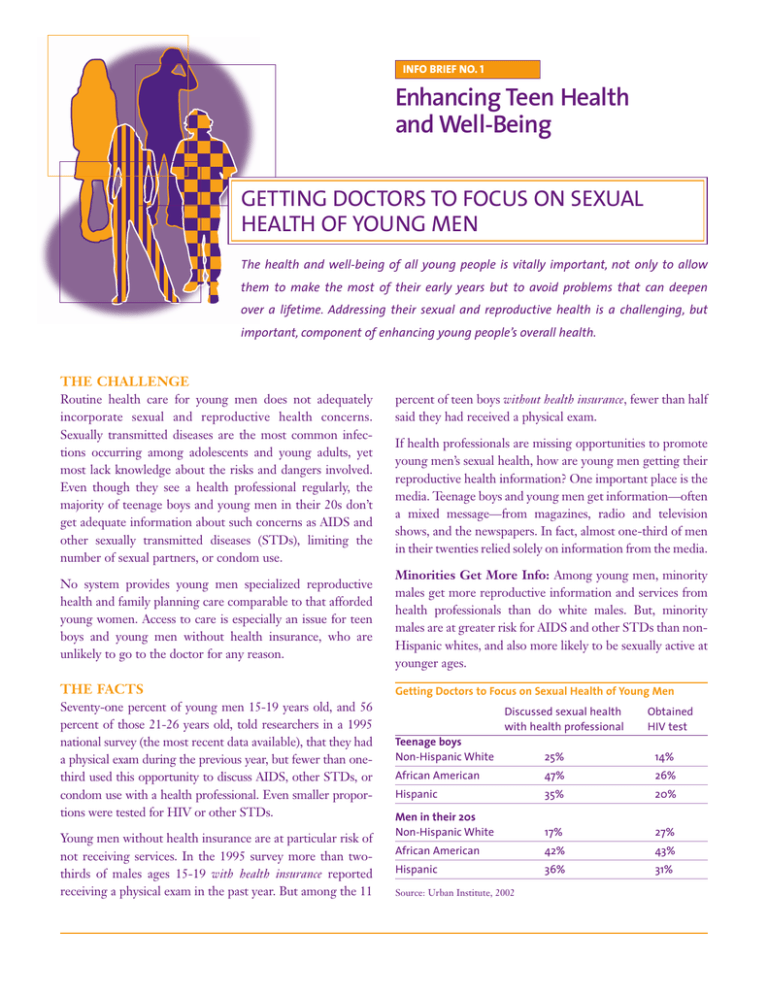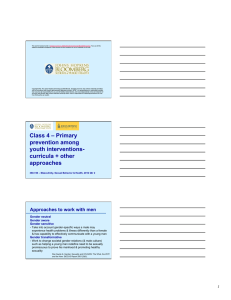
INFO BRIEF NO. 1
Enhancing Teen Health
and Well-Being
GETTING DOCTORS TO FOCUS ON SEXUAL
HEALTH OF YOUNG MEN
The health and well-being of all young people is vitally important, not only to allow
them to make the most of their early years but to avoid problems that can deepen
over a lifetime. Addressing their sexual and reproductive health is a challenging, but
important, component of enhancing young people’s overall health.
THE CHALLENGE
Routine health care for young men does not adequately
incorporate sexual and reproductive health concerns.
Sexually transmitted diseases are the most common infections occurring among adolescents and young adults, yet
most lack knowledge about the risks and dangers involved.
Even though they see a health professional regularly, the
majority of teenage boys and young men in their 20s don’t
get adequate information about such concerns as AIDS and
other sexually transmitted diseases (STDs), limiting the
number of sexual partners, or condom use.
No system provides young men specialized reproductive
health and family planning care comparable to that afforded
young women. Access to care is especially an issue for teen
boys and young men without health insurance, who are
unlikely to go to the doctor for any reason.
THE FACTS
Seventy-one percent of young men 15-19 years old, and 56
percent of those 21-26 years old, told researchers in a 1995
national survey (the most recent data available), that they had
a physical exam during the previous year, but fewer than onethird used this opportunity to discuss AIDS, other STDs, or
condom use with a health professional. Even smaller proportions were tested for HIV or other STDs.
Young men without health insurance are at particular risk of
not receiving services. In the 1995 survey more than twothirds of males ages 15-19 with health insurance reported
receiving a physical exam in the past year. But among the 11
percent of teen boys without health insurance, fewer than half
said they had received a physical exam.
If health professionals are missing opportunities to promote
young men’s sexual health, how are young men getting their
reproductive health information? One important place is the
media. Teenage boys and young men get information—often
a mixed message—from magazines, radio and television
shows, and the newspapers. In fact, almost one-third of men
in their twenties relied solely on information from the media.
Minorities Get More Info: Among young men, minority
males get more reproductive information and services from
health professionals than do white males. But, minority
males are at greater risk for AIDS and other STDs than nonHispanic whites, and also more likely to be sexually active at
younger ages.
Getting Doctors to Focus on Sexual Health of Young Men
Discussed sexual health
with health professional
Obtained
HIV test
Teenage boys
Non-Hispanic White
25%
14%
African American
47%
26%
Hispanic
35%
20%
Men in their 20s
Non-Hispanic White
17%
27%
African American
42%
43%
Hispanic
36%
31%
Source: Urban Institute, 2002
Young Adults Get Less Info But Face Greater Risks:
Young adult men have just as much—if not more—need for
reproductive health information and services as do teens, but
receive less. Young adulthood is the age of greatest sexual
activity. Men in their 20s have more sexual intercourse than
teen males but use condoms less often, resulting in greater
rates of STDs and unintended pregnancies. They are less
likely to see a doctor routinely, and less likely to receive
prevention messages in school.
Teenage Girls Affected by Young Men’s Behavior:
Age differences between sexual partners mean that sexual
risk-taking among men in their 20s often result in STDs and
unintended pregnancies among teenage girls. Making sure
that boys and young men have the necessary reproductive
information and services also helps promote the health of
girls and young women.
WHAT NEEDS TO BE DONE
Health professionals should seize existing opportunities and
create new ones to discuss sexual health issues and provide
related health services to teenage boys and to young men in
their 20s. These professionals must:
• Become confident and comfortable discussing sexual
issues, AIDS, STDs and condom use.
• Continually find ways to bring up issues related to
sexual health, and to urge young men to limit the
number of sexual partners, take tests for AIDS and
other STDs, as well as use condoms, if sexually
active.
• Make sexual and reproductive health services an
integral part of routine care visits for young men.
Health Intervention Programs must be located where
teenagers and men in their 20s can easily access them. Since
young men are less likely to visit a doctor than women, information by doctors must be supplemented by information
from other sources. Many young men are involved
in athletics and team sports. Health-focused programs can
partner with existing sports activities or sponsor new
sporting events to attract boys and young men. Job training
and placement services and workplaces could be targeted
to reach men in their 20s with limited ties to school or to
health professionals.
Sexual Risk Behaviors Among Young Men, by Age
PERCENT OF CONDOM USE
NUMBER OF TIMES HAD SEX IN LAST YEAR
100
100
80
80
% Condom Use
60
60
40
40
# Times Had Sex
20
0
20
AGE 15-17
18-19
21-23
24-26
Source: 1995 National Survey of Adolescent Males, Urban Institute, 2002
THE DATA
The statistical findings are based on analyses of data from the
1995 cohorts of the National Survey of Adolescent Males.
Program recommendations were compiled by The Young
Men’s Sexual and Reproductive Health Working Group,
convened by the Urban Institute.
FURTHER DETAILS
Sonenstein, Freya L., editor. 2000. Young Men’s Sexual and
Reproductive Health: Toward a National Strategy. Urban
Institute.
• Framework and Recommendations (November 2000)
• Getting Started (December 2000)
Bradner, Carolyn H., Leighton Ku, and Laura Duberstein
Lindberg. 2000. “Older, But Not Wiser: How Men Get
Information about AIDS and Sexually Transmitted Diseases
after High School,” Family Planning Perspectives 32(1): 33-38.
Porter, Laura E., and Leighton Ku. 2000. “Use of
Reproductive Health Services among Young Men, 1995.”
Journal of Adolescent Health 27: 186-194.
Sonenstein, Freya, Leighton Ku, Laura Duberstein Lindberg,
Charles Turner, and Joseph Pleck. 1998. “Changes in Sexual
Behavior and Condom Use among Teenaged Males: 1988 to
1995.” American Journal of Public Health 88(2): 956-959.
The views are those of the authors and do not necessarily reflect those
of the Urban Institute, its sponsors, or its board of trustees.
URBAN
INSTITUTE
MAY 2002
0
For more information contact public affairs at 202.261.5709
or visit our web site at www.urban.org






